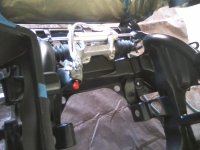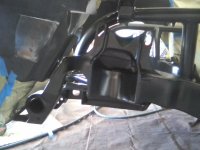mfain
Well-known member
Here is a little progress on something I have been working on for some time. I decided to go to a high travel/low roll front suspension on my 56 Corvette - 4.5 inches of compression with low camber gain, but lots of caster gain which translates to correct camber for both front wheels with turn (negative on the outside front, positive on the inside). Every suspension point and the rack are on "slugs" for adjustment of: Ackermann, bump steer, dynamic toe, camber and camber gain, caster and caster gain, anti-dive, and roll center. I moved "everything" so I could get clearance for up to a 13 inch wide front tire with 27.5 degrees of turn at full compression. I still need to glass in the new inner fender panels. I will use JRi shocks with special rebound valving and bump stops to keep the splitter off the ground. I am having custom, longer control arms built with bearing pivots and Howe low friction ball joints. They will couple to my existing ATS spindles with ZR1 bearings and Stop Tech brakes. It has been a lot of work, but I think the results will be worth it on a road course.





